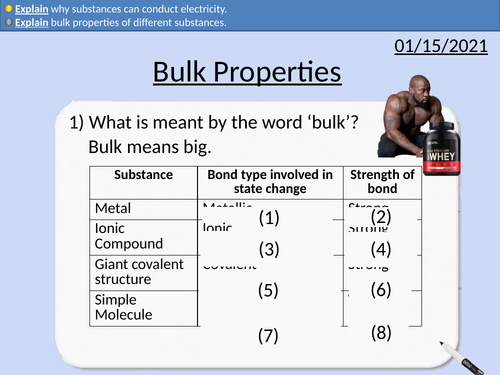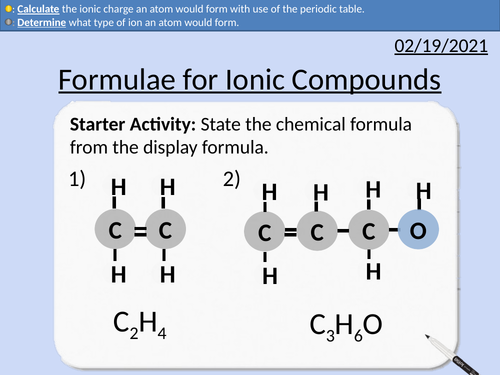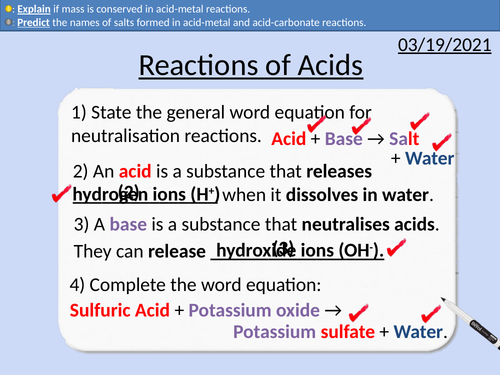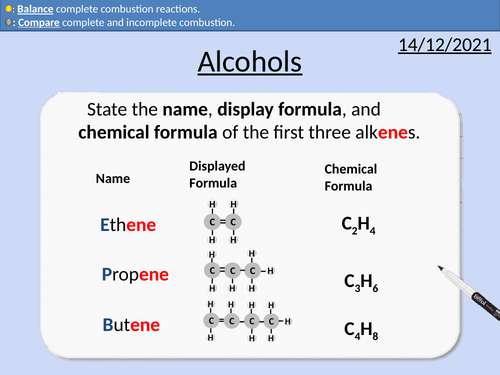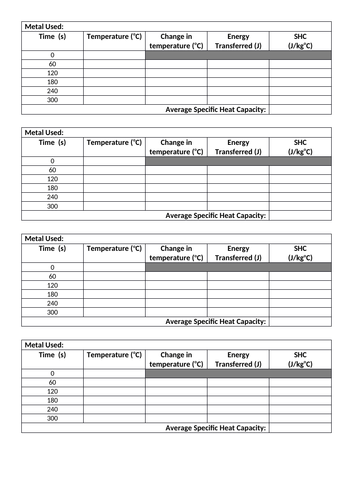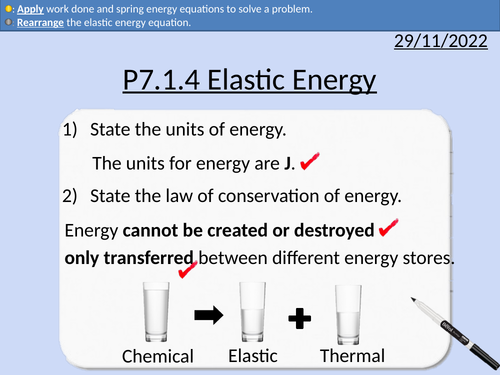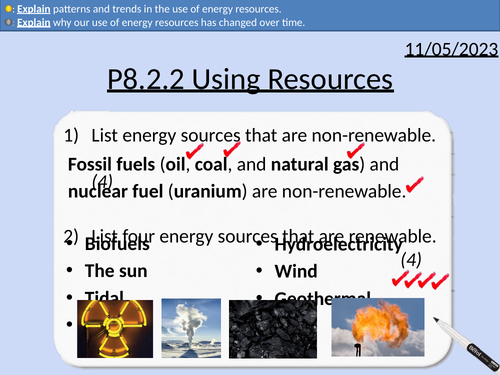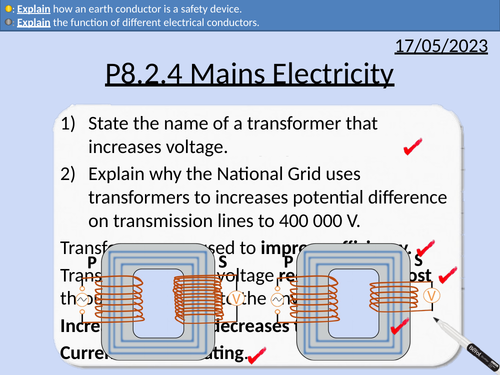497Uploads
169k+Views
72k+Downloads
All resources

GCSE Chemistry: Changing State
This PowerPoint presentation with worked examples and student questions covers:
• Define melting and boiling point of a pure substance.
• Predict the state of matter of substance at certain temperatures.
• State what the state of matter is of a substance due to the type of bonding.
• Metals, covalent structures, ionic structures and simple molecules.

GCSE Chemistry: Bulk Properties
This PowerPoint presentation with worked examples and student questions covers:
• Jobs in Material Science
• Bulk properties of metals - malleable and conductors of electricity
• Bulk properties of ionic and covalent structures - brittle
• Explain why substances conducting electricity depends upon the state of matter

GCSE Chemistry: Formulae of Elements and Molecules
This PowerPoint presentation with worked examples and student questions covers:
• State the number of elements in a chemical formula.
• Determine the chemical formula from display formula.
• Dot and cross diagrams for bonded atoms

GCSE Chemistry: Formulae for Ionic Compounds
This PowerPoint presentation with worked examples and student questions covers:
• State the number of electrons in each energy level.
• Determine what type of ion an atom would form.
• Calculate the ionic charge an atom would form with use of the periodic table.
• Groups number, outer shell electrons, dot and cross diagrams

GCSE Chemistry: Reactions of Acids
This PowerPoint presentation with worked examples and student questions covers:
• Identifying metals on the periodic table
• Predicting the salt formed in acid metal reactions.
• Predicting the salt formed in acid carbonate reactions.
• Conservation of mass and state symbols

GCSE Chemistry: Transition Metals
This PowerPoint presentation with worked examples and student questions covers:
• Properties of transition metals gases
• Comparing transition metals with alkali metals
• Everyday applications of transition metals
• Transition metals as catalysts

GCSE Chemistry: Alcohols
This PowerPoint presentation with worked examples and student questions covers:
• Functional groups of alcohols, alkanes, and alkenes.
• Comparing incomplete and complete combustion of alcohols
• Mnemonic device for naming alcohols
• General formula for alcohols
• Drawing the structural formula for alcohols

GCSE Physics: Specific Heat Capacity Practical
This presentation covers OCR Gateway Physics 9-1 P1.2.3
Presentation includes:
Instructions for experiment
Results table
Rearranging of SHC equation
Exam style question and answer

GCSE Physics: Density
This presentation covers OCR Gateway Physics 9-1 P1.2.1
Presentation includes
Calculating volume for regular shapes
Conversion from grams (g) to kilograms (kg) and centimetres (cm) to meters (m) with exercise and answers
Converting with standard form with examples and solutions
Applying the density equation with examples and solutions
Proportionalities
Plenary exam question and solution

GCSE Physics: Specific Heat Capacity
This presentation covers OCR Gateway Physics 9-1 P1.2.3
Presentation includes:
Definition of SHC
Real life examples of SHC
SHC equation with example
SHC equation questions with worked solutions
Exam question with solution

GCSE Physics: Nuclear Equations
This presentation covers OCR Gateway Physics 9-1 P6.1.3 Nuclear Equations
All presentations come with student activities and worked solutions.
Nuclear Notation - mass number and atomic number
Nuclear equations for emissions of:
Alpha radiation
Beta radiation
Gamma radiation

GCSE Physics: Kinetic energy and Work done
This presentation covers OCR Gateway Physics 9-1 P7.1.1b Kinetic energy and Work done.
PowerPoint includes student activities with fully worked answers included.
Work done and kinetic energy equations
Rearranging equations
Mechanical energy transfer and work done
Kinetic store transfered mechanically to a thermal store through brakes.

GCSE Physics: Work Done and Elastic Energy
This presentation covers OCR Gateway Physics 9-1 P7.1.4 Work Done and Spring Energy.
Use of Springs
Measuring Extension of a Spring
Rearranging Spring Energy Equation
Rearranging Kinetic Energy Equation
Practice Questions with Worked Solutions

OCR AS Chemistry: Electrophilic Addition in Alkenes
OCR AS Chemistry: 13.4 Electrophilic Addition in Alkenes
This PowerPoint is a whole lessons included with student activities, animated answers, homework questions with answers provided.
This lesson covers:
Electrophile molecules
Electronegativity
Reaction mechanisms for addition reaction of alkenes and hydrogen halides
Carbocations and stability
Markownikoff’s Rule

GCSE Physics: Simple Circuits
This presentation covers OCR Gateway Physics 9-1 P3.2.1 Simple Circuits.
Circuit Symbols
Electric field lines and potential difference
Modeling Circuits with Rope
Measuring Potential Difference
Energy Transferred Equation for Electricity
Rearranging Equations

GCSE Physics: Paying for Electricity
This presentation covers OCR Gateway Physics 9-1 P7.2.1 Paying for Electricity
A unit of electricity being a kilo-watt hour (kWh)
Unit cost and calculating costs
Energy bills
Electrical power
Work done = Power x Time
Power = Potential Difference x Current

GCSE Physics: The Acceleration Equation
This PowerPoint presentation with worked examples and student questions covers:
• Acceleration equation with units
• Speed-time graphs

GCSE Physics: Energy Resources
This presentation covers OCR Gateway Physics 9-1 P8.2.2 Energy Resources
This PowerPoint is a whole lessons included with student activities and animated answers.
How use of energy resources have changed over time. (Biofuels, Fossil Fuels, Nuclear, Renewable).
How energy use has increased (increase population and development of technology)
Explain patterns and trends in the use of energy resources.
Fossil fuels are finite and will run out at current consumption levels.

GCSE Physics: The National Grid
This presentation covers OCR Gateway Physics 9-1 P8.2.3 The National Grid
This PowerPoint is a whole lessons included with student activities and animated answers.
Structure of the National Grid
Step-up and Step-down transformers
How transformers increase the efficiency of the National Grid
Number of turns and potential difference
Current and potential difference in primary and secondary coils

GCSE Physics: Mains Electricity
This presentation covers OCR Gateway Physics 9-1 P8.2.4 Mains Electricity
This PowerPoint is a whole lessons included with student activities and animated answers.
Domestic Electrical Supply being 230 V, AC at 50 Hz.
Direct potential difference and alternating potential difference.
Reasons for insulation on wires.
Potential Difference between different conductors.
Function of the earth conductor.
Double insulation and no earth wire.
Reasons the live wire is dangerous.
Reasons why live to earth is dangerous.


